
Two Late Han to Jin Bows from
Gansu and Khotan
Stephen Selby. © Stephen Selby, 2002
(originally published as ATARN Newsletters in April and September 2002)
A desert tomb in Jiayuguan, Gansu, Western China, has recently yielded up a wooden, model bow. Bede Dwyer and Grózer Csaba, who have both pre-viewed the pictures, consider that this bow is a full-scale model of a horn and sinew bow. The bow is in light-weight wood carved from two pieces. The two pieces unite at a splice at the grip. There is no sinew visible on it, and just a little birch bark remains adhering to the back of the bow.
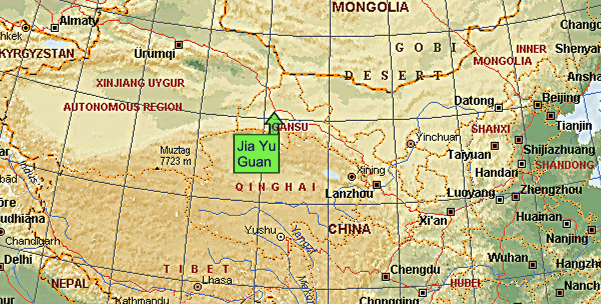
The bow comes from near Jiayuguan in Gansu, China.
This map is reproduced from the Microsoft Encarta World Atlas in accordance with
the
licence conditions concerning use in free flyers not sold in any form or
context. Copyright reserved.

The two wooden components, with the grip splice to the right and the tips to
the left
Above is a photograph of the two parts of the bow. The main working part of the limb forms a broad plate, bearing a painted design on each.

Side view of one of the siyahs. The tip is broken off about 5cm short of the
end on the right.

Dragon painted on one of the limbs (belly side) in black, white, red and
ochre.
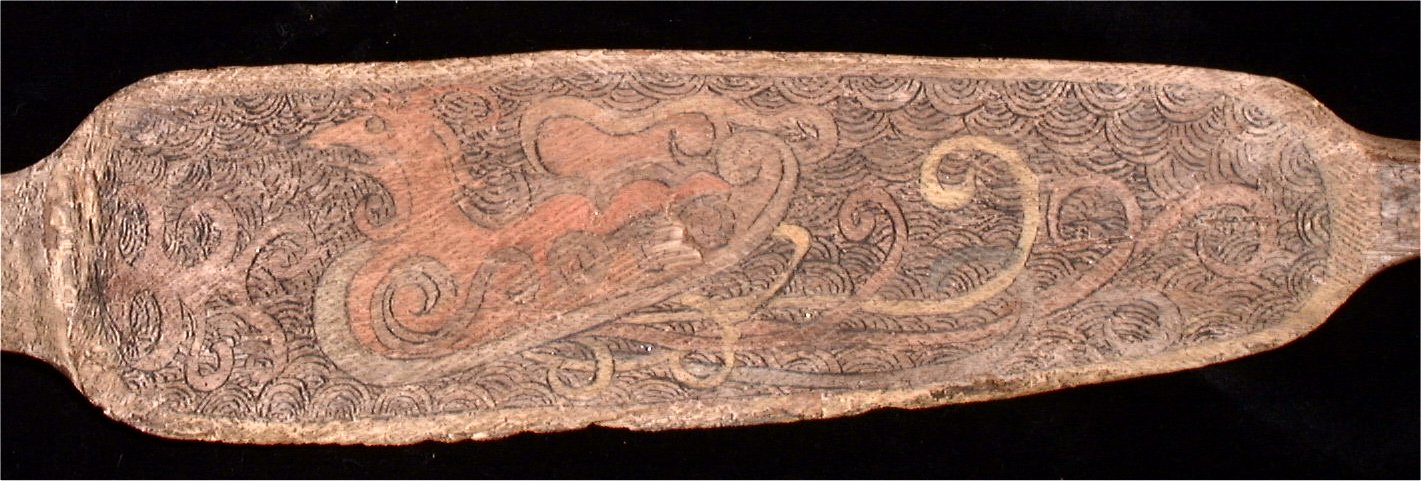
'Phoenix' painted on one of the limbs (belly side) in black, white, red and
ochre.
These dragon and phoenix designs should not be interpreted in terms of modern Chinese symbolism. This bow came from a group of graves dating from the Wei/Eastern Jin period, around 260CE. At that time, the dragon was the 'black dragon' -- a Daoist symbol of the East, while the bird was the 'red bird' -- denoting the South. Both symbols were derived from constellations, and continued in use from the Han dynasty. Such images would allow the soul of the deceased to rest in peace.
|
|
|
The black dragon and red bird from Eastern Jin tomb tiles.

Painted cicada design from the siyah of the bow
The cicada design on the limb also represents a hold-over from the Han Dynasty, representing a return to life for the deceased (because the cicada was thought to return to life in springtime from a dry, lifeless state in the winter.)

Floral design on the side of the grip splice.
The flower on the grip may be 'hai tang' (crab-apple) which rhymed with the word for 'high rank'.

The two splices placed together to form the core of the grip.

Basketwork pattern on the top of the siyah.

Two wood elements joined at the grip splice (vertical view).

Two wood elements joined at the grip splice (side view).
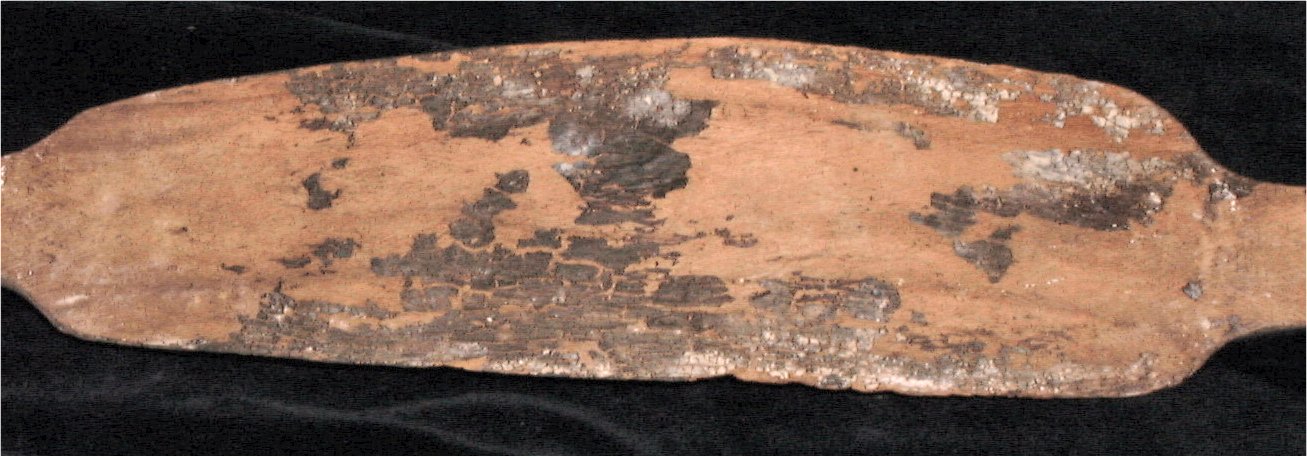
On the back of the main working parts of the limb, there are some remains of
blackened birch-bark.

Scraping on the wooden surface of the bow.
Every wooden surface of the bow - whether painted or not - has been scraped transversely in two directions, apparently with the teeth of a saw. I cannot work out why that should be. When wood is scraped so that horn or sinew can be attached, it is usually just scraped in one direction - lengthwise.
The original bow would have had bone reinforcement at the grip, and indeed the pieces that I have shown in previous newsletters would fit well (although they undoubtedly come from different specimens.)

Bow-tip reinforcement (not found with this bow)
Bow grip reinforcement (not found with this bow)
I was interested to see how the bone plates I discussed in the March 2002 newsletter (above) would fit to this bow. The following photographs show how:

Possible placement of the bone reinforcement for the face of the grip.
Two years ago, I reported about the Niya bow that was discovered in 1999. Since the Niya find shared the same late horizon with the Gansu bow - the Eastern Jin period - I was interested to see how they might compare.
First, this is how I would reconstruct the Gansu bow:

Reconstruction of the Gansu bow unstrung, with bone string-nocks and
grip-reinforcement.

Reconstruction of the Gansu bow string
And now my reconstruction of the Niya bow for comparison:

Reconstrution of the Niya bow (oblique, viewed from below)
Clearly, there are some striking similarities between the Gansu bow and the Niya bow. The design seems to have been very durable among the borderland people of China, and was probably closely related to the Song and Yuan bow designs in use in these pictures:
|
|
|
This is where the SVG file comes in. I have prepared a dimensioned drawing of the Gansu bow. If you have downloaded Adobe's SVG viewer plug-in, you can look at the bow and the plan in detail.
In fact, in the same group of graves as the one from which this bow came, there was a painted panel showing a scene of hunting with bows on horseback.

Scene of hunting with bows on horseback from the same date and
location as the Gansu bow.
Click here
for the detailed dimensioned plan of the Gansu bow in SVG file format.
I look forward to reading your views and ideas on ATARNet. Please start a new thread, 'Gansu Bow' under 'hardware'.
While in Xinjiang in May 2002, I was given the opportunity to study a number of bows preserved in Xinjiang's Institute of Archaeology and the museums at Urumqi and Turfan.
I had the chance to study three types of bow, all three of which had at one time or another been buried like mummies in the frozen, dry sands of the Xinjiang deserts. One of the bow groups I studied dated from the very end of the Han Dynasty or into the Wei-Jin period. That is, from around 250-350CE.
On studying this group of three, almost identical bows closely, a couple of points became immediately clear.
First, the description of the Niya bow in
The second point was that, clearly, the bows I was observing were full working bows of the same design described in my previous letter on the Gansu Bow. These bows show beyond doubt that my Gansu Bow was a full-scale model in wood of a bow that would normally be made of wood, sinew and horn.
The second point is of some importance in itself. Despite reading frequently of 'model bows' placed in graves, the 'Gansu Bow' is only the second certain example I have come across. (The first is a Liao Dynasty wooden model of a bow and box quiver .)
My examination of the three bows in the Museums gave me a chance to glean some data and correct general wrong preconceptions about these bows. However, everything I examined was behind glass and I was not permitted to take photographs (although I could sketch to my heart's content.) Even my measurements had to be estimated (supplemented by earnest attempts by the archaeologists with me to recall actual measurements.) The golden opportunity came, however, when a junk dealer in Xinjiang sold me one half of an original bow (together with one half of the original string and six arrows) that had come from Khotan. So identical was this bow to those I had seen in the museums that I have no hesitation in saying that this 'Khotan bow' provides a basis for a detailed description of the 'Niya Bow' genus.
I have been generously helped by Mr W. F. Lai, Conservator of the Hong Kong Museum of History. He helped with the measurement process and has undertaken the X-ray photography. In a later newsletter, he will provide identification of the wood and other materials used in making the bow. At this point, I'll cut the cackle and let you see photographs of the bow, with my observations.
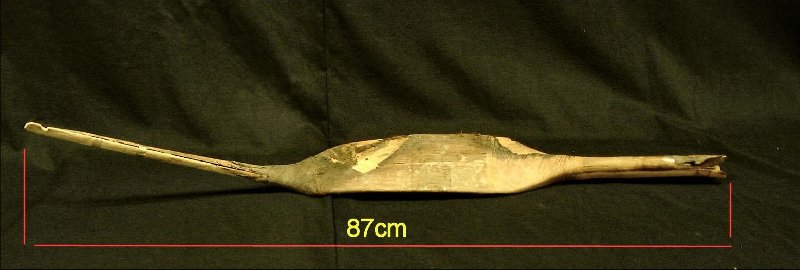

Back view. Bone limb reinforcement present on one side only. A
triangle of silk adheres to the top of the limb.

X-ray through back of the bow. (Composite of three.)


Side view of the grip, limb and siyah with surface
measurements.

X-ray through grip, limb and siyah

Detail of sinew reinforcement at limb/grip junction and bone
plates reinforcing side and belly of grip.
(The profile of the back of the grip is formed with sinew.)

X-ray through the limb/grip junction.
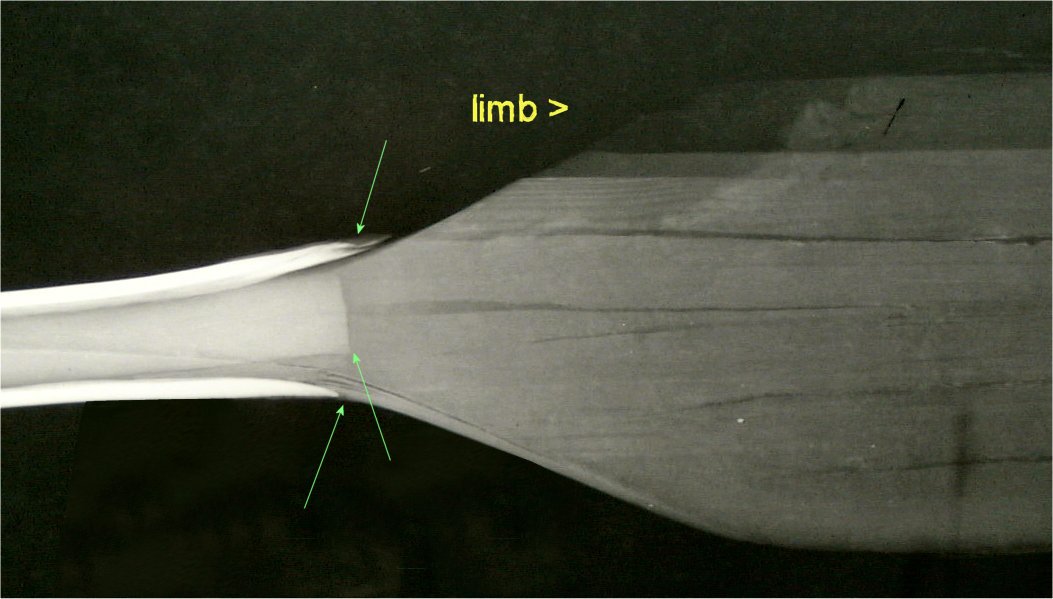
X-ray through grip/limb transition

The belly of the limb, formed of five horn plates over wood.
(Adhesive tape across the middle.) Lowest plate is missing.

X-ray through siyah/limb transition from back. Sinew
(see picture below) hides additional bone reinforcements .
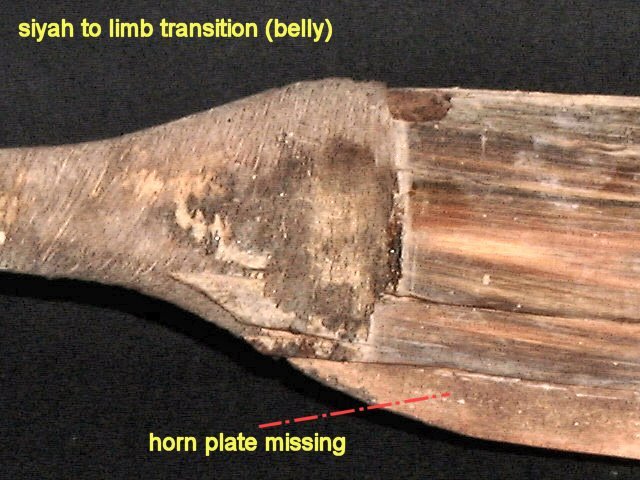
Detail of siyah/limb transition with sinew reinforcement.

X-ray through siyah/limb transition from side shows up an
extension of horn along the belly of the siyah.

The bow viewed from the tip looking towards the grip
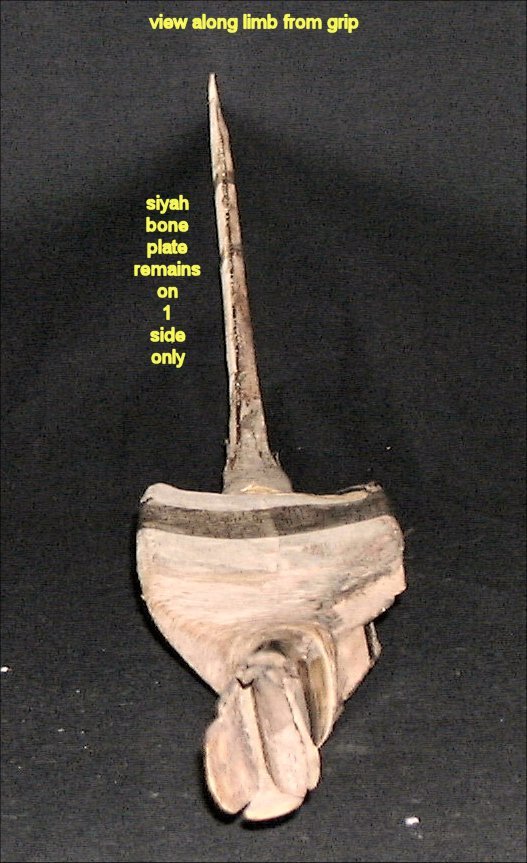
Looking from the grip to the siyah

The bone reinforcement to the tip/siyah. I surmise that the
extent of the wooden core was originally the same as the bone reinforcement.
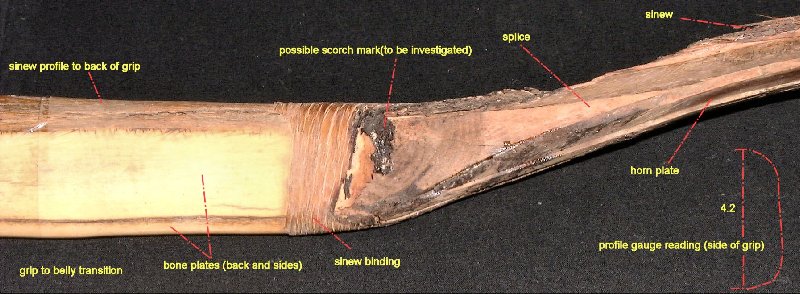
This photograph provides clues to the construction of the
grip/limb transition.
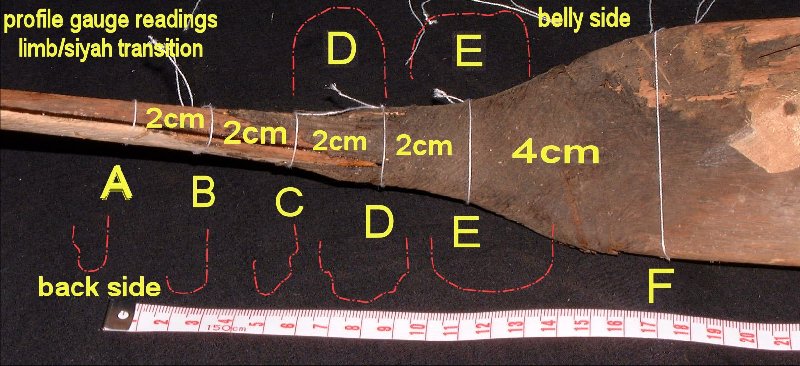
Cotton thread tied at measured intervals, with contour
gauge readings from the back (and belly at D, E.)

X-ray through grip from the back shows splice of limb/grip and
interstitial wood insert in the grip.

What remains of the original string.

The loop seems to have been formed like a modern bow string and
then wrapped in the skin of a small, furry animal.

Six original self wooden arrows. But the points have all been
snapped off before burial.
Arrow Measurements
| Length(cm) | Max. diameter(cm) | Min. Diameter(cm) |
| 80.4 | 0.995 | 0.770 |
| 74.4 | 0.910 | 0.610 |
| 60.6 | 0.910 | 0.605 |
| 76.8 | 0.910 | 0.605 |
| 75.8 | 0.910 | 0.605 |
| 61.0 | 0.895 | 0.715 |
| 78.4 | 0.905 | 0.710 |
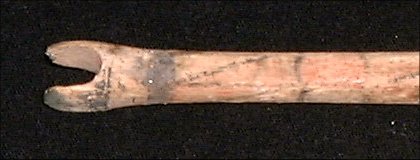
Self-wood bulbous nock. Painted, but no sign of reinforcement
or inserts.
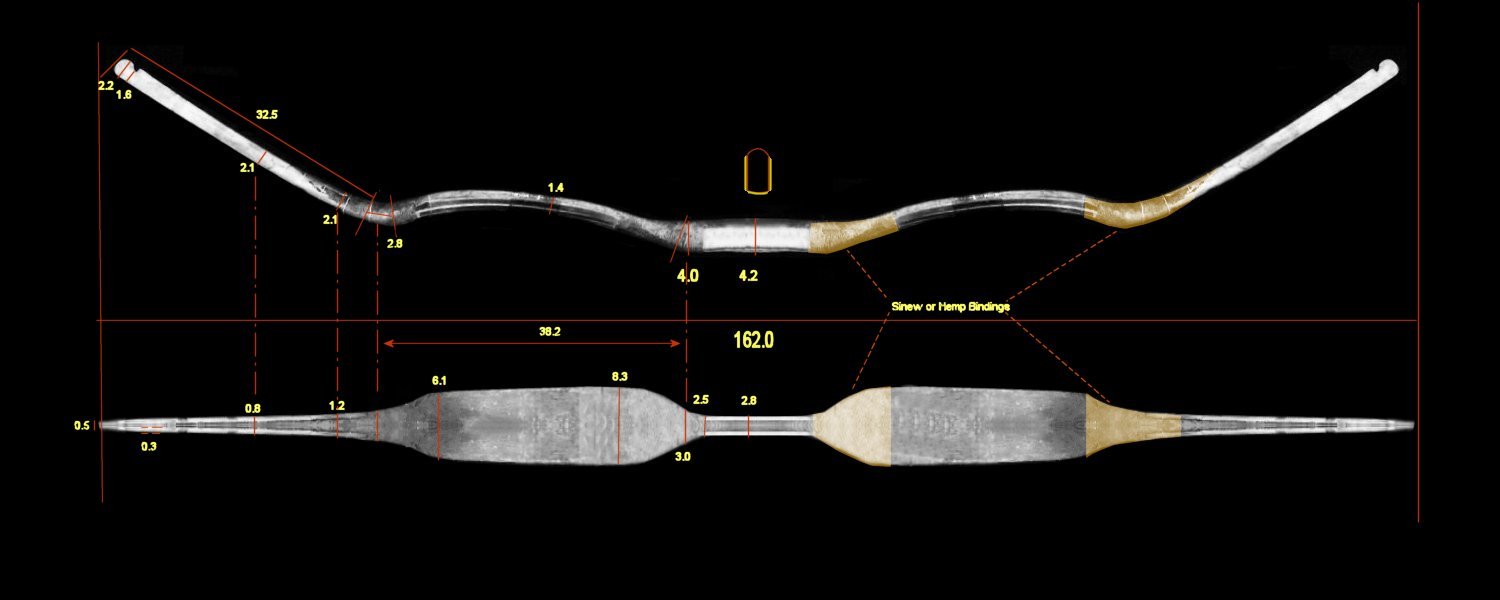
Here, I use computer magic to repair the bow and supply dimensions. This
exercise assumes symmetry around two axes.
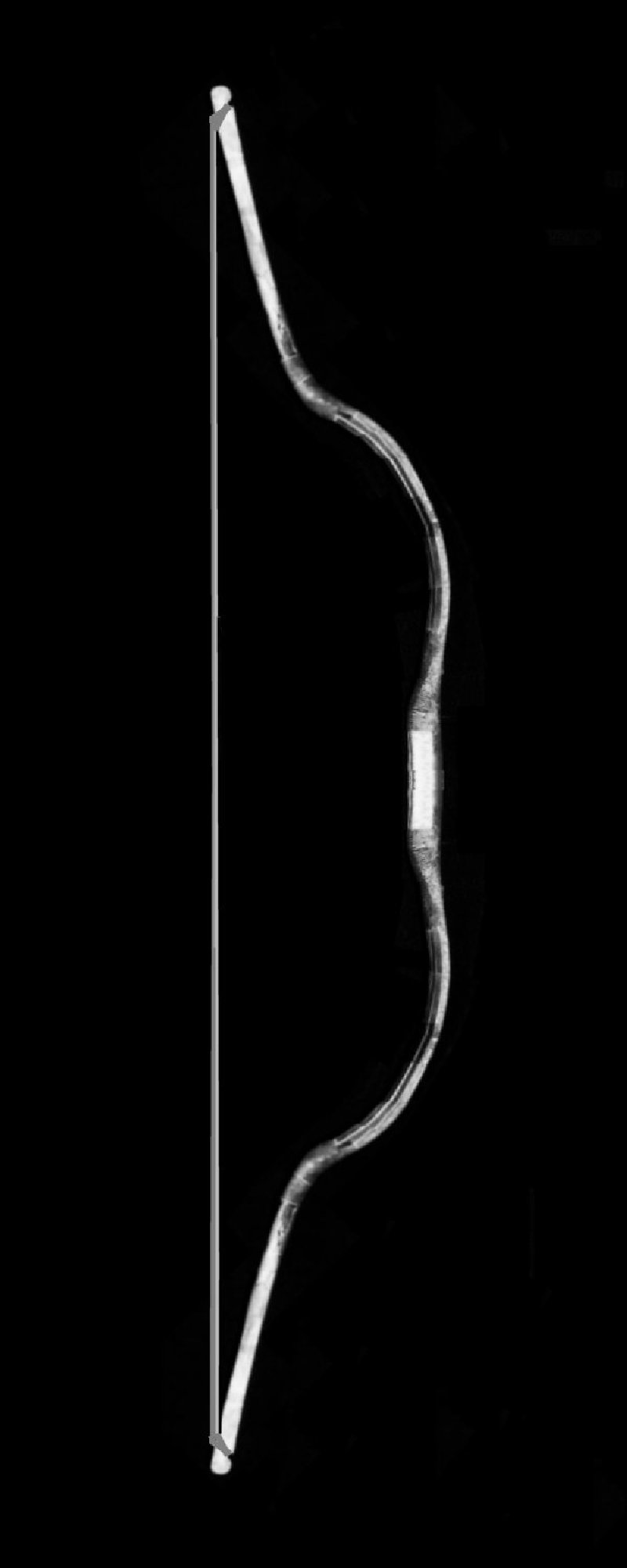
More computer magic: ready to shoot!
Archaeological and historical background of the Khotan bows.
A bow of identical design to the one I have just described was excavated at Niya on 11 October 1995. A coffin containing four male mummies and two bows was exhumed unopened and then examined in relatively ideal laboratory conditions in Urumqi in the following months. The description of the contents of the coffin from grave #4 at cemetery #95 at Niya was published in "Xinjiang Wenwu" ('Xinjiang Cultural Relics') Issue No. 2 of 1999, p. 27. There is some further comment in Wang Binghua (with Victor H. Mair), "The Ancient Corpses of Xinjiang", Xinjiang People's Press, 2002. ISBN 7-228-05161-0. Further background information (in Chinese) and illustrations is provided in Liu Wei: "Chinese Civilization in a New Light" Vol. 4. Commercial Press, Hong Kong, 2001. ISBN 962-07-5307-0.
The Niya site corresponds geographically to the location of a culture which occupied the Niya area throughout the Eastern Han and Western Jin periods, around 200-350CE. Situated in the remote desert, Niya was once irrigated by the Niya river, fed by the melting snows of the Kunlun Mountains.
In Chinese literature, the people occupying that region in those times were known as the 'Jingjue' (精絕). The 'Official History of the Han: Record of the Western Regions' (漢書西域傳) records that the Jingjue were one of 36 large and small vassal states in the West of the Empire. 480 households with a total population of over 3,000 people were recorded. Their armed forces amounted to 500 men. The Han government posted four officials there for administrative purposes. An invasion of the region by the Tuguhun in the fifth century caused economic disruption. Water supply to the Niya river was cut of and the desert encroached. (Archaeological surveys by Aurel Stein in the 19th Century and surveys by Chinese and Japanese archaeologists since the 1950s suggest, however, that the area was abandoned over a rather short period, with many valuable items left scattered.) By the time that the Tang monk-explorer Xuanzhang passed the site in the 7th Century, it was already a ruin.
The mummified remains from Cemetery #95 generally display non-Chinese racial characteristics, with light brown or blond hair and high, aquiline noses. Men were around 1.65 meters tall. They lived in a prosperous community which enjoyed the best luxury products from both East and West. Foods preserved in graves show that their diet was mainly mutton, grains and dried fruits (in fact, much the same as present-day inhabitants of the region.) Particularly striking (partly because their spectacular state of preservation) are the embroidered cloths in silk and wool that the mummies are buried in. The people were literate. In common with other cultures in the region at that time, they kept civil records in the Kharoşţh-ī-Prakrit script, that originated in Northern India.
Several of the deceased at Niya had died violently. Males were buried together with grave goods which in most cases included a bow, bow-case, quiver and arrows. Bows were clearly standard, emblematic burial items for males. Most of the bows were composite bows such as the one described here; but simple wood self bows about 1.5m long were also found. Arrows were self wood barreled and either had blunt wooden points, or else had had metal arrowheads removed before burial. Women were buried with make-up kits and items related to sewing and weaving. Where coffins were placed above previous burials, the previous burials were sometimes burned.
Coffin #4 from cemetery #95 also contained a piece of brocade with a vivid design of mounted archers using bows that were consistent with the design of the bow described here. Another mummy discovered nearby had a brocade bracer on his arm, embroidered with the Chinese text "Five stars appear in the East: the Central States will benefit and the Southern Qiang will be punished." This brocade may be a gift from the Chinese court to minority tribes who helped the Chinese to suppress incursions from the Southern Qiang (Tibetans.)

A piece of brocade with a vivid design of mounted
archers using bows consistent with the design of the bow described here.
(Based on an illustration in Xinjiang Wenwu"
('Xinjiang Cultural Relics') Issue No. 2 of 1999.)
You may copy and make non-commercial use of this drawing.
Commentary
Feeling a sense of déja-vu? Open 'The Traditional Bowyer's Bible', Vol. 3 at page 82. Look at Tim Baker's suggestion for a theoretical design for maximized performance of a composite bow. Someone got around to trying out his design... 1,700 years ago.
In this bow design, the working limbs amount to little more than spring-leaf hinges. From the X-rays, we can see that the bow needed careful reinforcement at the edges of regions where the working sections and non-working sections are spliced. We also see that the central horn plate of the belly extends half-way up the siyah. As far as can be ascertained, the wooden core consists of two pieces of wood, each carved in one piece from the tip to the grip, with a short interstitial piece of wood between them.
While Tim Baker anticipates the short, rectangular working limb, he does not anticipate the spoon-shaped hollowing of the limbs (which is corroborated by the Gansu bow.) Without actually constructing this bow, it is difficult to understand the purpose of such a feature. Personally, I could imagine the hollow-profile limb giving rises to enormous stresses at the edges. What happened in reality?
One element of the design helps to deal with a problem that we observed in the area where these bows were made: there is little prospect of obtaining long sections of good, consistent horn and the principal woods are light and lack hardness and sappiness. The short working limb permits the use of short plates of horn. The addition of slivers of bone (horse or camel) as reinforcement allows construction of very light but strong non-working sections. I would go as far as to say that this bow is principally constructed of bone, horn and sinew: the role of the wood core in the construction is limited to a scaffolding to facilitate the assembly of the other materials.
For a further interactive discussion of this bow, please look for the new discussion topic on ATARNet.
(Follow-up discussion up to 21 July 2002 can be seen here.)
Last edited 20 November 2002